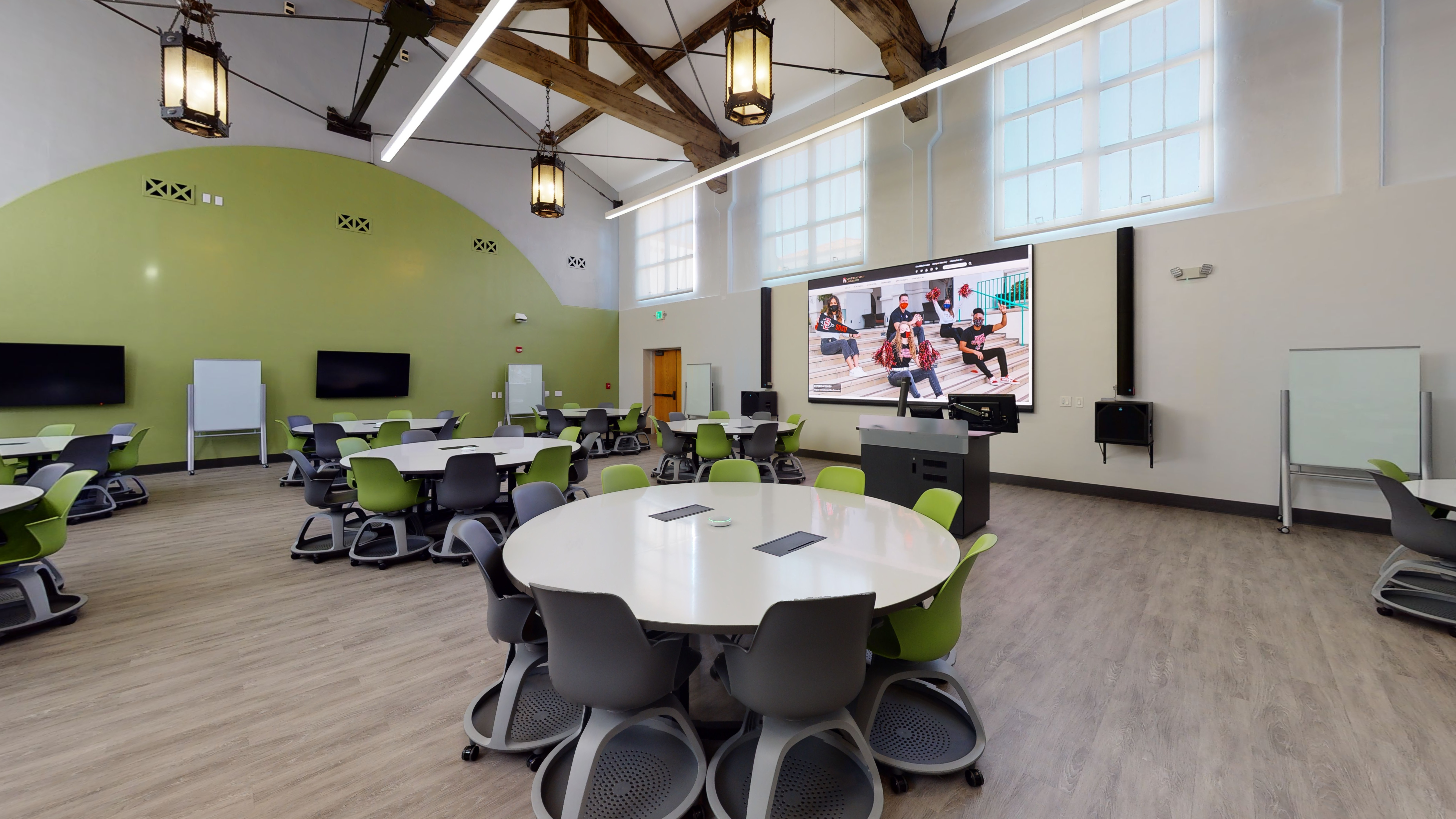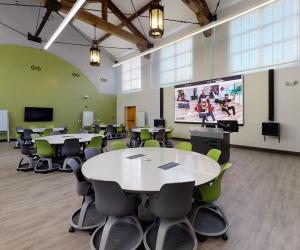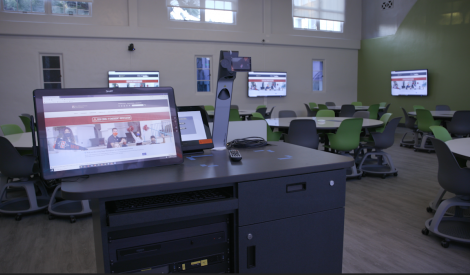
SPACE DETAILS
Learning Space Rating System v3
REFORMULATION: The LSRS is a scoring tool that measures a classroom's potential to support multiple modes of learning and teaching. For more information go here.
WHAT'S INSIDE
TECHNICAL SPECS
Furniture/Layout
- Seating: Steelcase Node with tripod base
- Tables: Omni (custom) 84" diameter, 9 seats. Whiteboard writable surface with 2 electrical units with 4 outlets per unit, fixed.
- ADA Considerations: ADA compliant access. Additional ADA compliant seating, good movement in the room.
- Windows: Eastern and Western facing windows near ceiling, allows for natural lighting. Additional windows, eye level on Western wall. Electric, Mecho Shades on windows near ceiling.
- Lighting: Dimmable LED lighting, two zones. Additional historical chandeliers.
- Adjacent spaces: Exits to an indoor walkway, no adjacent study areas. Adjacent outdoor courtyard (grass) with bench seating.
- Whiteboards: Student tabletops. Movable/portable glass whiteboard surfaces.
- Storage: Storage closet for equipment.
- Construction/Configuration: Acoustic paneling on walls and ceiling. High NRC LVT flooring.
A/V Technology
- Control: Extron touch panel and processor. A/V matrixing using Extron NAV system.
- Video: 1 NEC 165" DvLED Video Wall Display. 7 NEC 65" Multisync LED Displays.
- Audio: Extron DMP 128 Plus audio mixing. 2 Shure QLX-D instructor wireless microphones and 11 MXA310 tabletop student microphones. 2 Renkus-Heinz IC-R steerable speakers with 2 S-Series subwoofers.
- Connected Classroom: SonicFoundry Mediasite Recorder for recording. PTZOptics 30x PTZ camera. All microphones and PTZ camera output to the Mediasite Recorder and are connected to the instructor Mac and PC via a Blackmagic Webpresenter for live streaming and recording through Zoom software (pre-installed in the built-in computers).
- Instructor Podium: 1 Mac Mini. 1 Dell Optiplex Micro. 1 LG BluRay player. 1 Mersive Solstice Pods. 1 Wolfvision tabletop document camera. 2 wired laptop connections (1 USB-C, 1 HDMI). 1 SMART Technologies Smart Podium interactive display (instructor monitor).
- Student Connectivity: 7 Mersive Solstice Pods
Explore The 3D Space via Matterport
Watch the Documentary Film here by Ethan Garcia titled “Designing and Documenting the Largest Active Learning Classroom at SDSU" that won the 2022 DET/CHE Annual Conference Member's Choice Award for Best Presentation.
The Story
Planning and Design
Physical Sciences, Room 130 (PS 130) represents a necessary addition to our learning environment inventory because it is designed specifically to promote and support active (e.g., problem, project or team-based) learning and due to the flexibility it provides for social distancing guidelines. The completion of this classroom remodel, at a reduced capacity of 30% due to COVID-19, allows faculty to teach in an active learning space that is also equipped with Connected Classroom technology.
According to the seminal meta-analysis by Freeman et al. (2014), “... active learning leads to increases in examination performance that would raise average grades by a half a letter, and that failure rates under traditional lecturing increase by 55% over the rates observed under active learning.” With this data as context, increasing the number of active learning environments on campus can be seen as essential in order to align with SDSU’s strategic priority for decreasing time-to-degree and improving our four and six-year graduation rates.
In addition, our current active learning environments such as AH 1112, AH 1120, EBA 410 and SH 104 are not able to fully accommodate the courses typically scheduled within them due to social distancing guidelines. Due to the size and layout of PS 130, we are able to accommodate many of those courses that otherwise would have no active learning space to utilize. At a reduced capacity, instead of the usual 100 capacity, PS 130 can accommodate at least 30 students plus the instructor.
Impact and User Response
Lessons learned in the Learning Research Studios are helping ITS to provide support and leadership to the university in the effective uses of technologies for enhancing learning as well as facilitating research and strategic initiatives. The LRS is fostering collaboration and innovation with faculty and university stakeholders in the design, development, effective use and evaluation of learning environments and emerging educational technology. As we redesign and upgrade our older LRS space and increase and diversify the use of the newer space, we will grow our presence on campus and beyond, creating a venue for faculty to explore dynamic new ways to design their courses and for students to engage in a more contemporary learning milieu. Comments here based on 2014 paper: Examining Learning Research Studios at San Diego State University by Frazee, JP, Hughes, KD, Frazee, RV. http://its.sdsu.edu/lrs/









